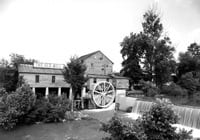 Pigeon Forge, Tennessee, has a rich and interesting history that has shaped it into the popular tourist destination it is today. During the late 1700s, settlers from the Carolinas followed old Indian trails through the Smoky Mountains along the Pigeon River to what is today Pigeon Forge. A treaty signed in the late 1700s opened the fertile valley for settlement. Pioneer Isaac Love established an iron forge here in 1820 and his son, William, built a tub mill ten years later. The Old Mill, now a National Historic Site, remains operational. In the 1700s and early 1800s the river’s banks were lined with beech trees. Beechnuts were a mainstay in the diet of Passenger Pigeons, which made the river a natural stopping point for huge flocks of the now-extinct species. The iron forge and the flocks of pigeons that fed along the river banks in the early years gave the town its name.
Pigeon Forge, Tennessee, has a rich and interesting history that has shaped it into the popular tourist destination it is today. During the late 1700s, settlers from the Carolinas followed old Indian trails through the Smoky Mountains along the Pigeon River to what is today Pigeon Forge. A treaty signed in the late 1700s opened the fertile valley for settlement. Pioneer Isaac Love established an iron forge here in 1820 and his son, William, built a tub mill ten years later. The Old Mill, now a National Historic Site, remains operational. In the 1700s and early 1800s the river’s banks were lined with beech trees. Beechnuts were a mainstay in the diet of Passenger Pigeons, which made the river a natural stopping point for huge flocks of the now-extinct species. The iron forge and the flocks of pigeons that fed along the river banks in the early years gave the town its name.
In 1907, population records show Pigeon Forge with only 154 residents. Pigeon Forge continued as a sleepy farming community until the Great Smoky Mountains National Park was dedicated in 1940. In 1946, a landmark sale of the first parcel of property was sold. It was at this time that along the river the main road was cut through town and included two general stores and two churches. The town slowly began to grow, incorporating in 1961. The tourism boom hit the city in 1982 and since then, growth has been rapid and Pigeon Forge has become one of the most popular vacation destinations in the Southeast United States.
Located in the foothills of the Great Smoky Mountains in Eastern Tennessee, Pigeon Forge is within a day’s drive of two-thirds of the nation’s population east of the Mississippi River. The resort town is 33 miles southeast of Knoxville, four miles south of Sevierville, six miles north of Gatlinburg, and five miles north of the most popular park in the U.S., Great Smoky Mountains National Park.
Today, Pigeon Forge has transformed into a vibrant and bustling tourist destination known for its attractions, entertainment venues, outlet malls, theaters, and outdoor recreational opportunities. It continues to attract millions of visitors each year who come to enjoy the natural beauty of the Smoky Mountains and experience the unique charm and history of Pigeon Forge.
Pigeon Forge is a town built for family fun! Voted one of the South’s favorite shopping spots by Southern Living readers, Pigeon Forge is equally famous for its more than 200 factory outlets and specialty stores. Packed with music theaters and family attractions, it is also home to the state’s top tourist attraction Dollywood. The climate in Pigeon Forge is almost perfect. Summer is usually balmy with an average temperature of 84 degrees. Winter is moderately cold with an average temperature of 40 degrees. The family atmosphere in Pigeon Forge lends itself to casual attire. Light clothing for the summer is best and layers work well in the winter. If you’re heading into the Smoky Mountains, take a jacket along since the temperatures are cooler at higher elevations.
Serving the interstate highway complex of I-75, I-40, I-81 into Pigeon Forge is State Route 66 and US Highways 411, 441 and 321. Knoxville’s McGhee-Tyson Airport is only 40 miles away and is served by eleven airlines with connecting services from cities including Memphis, Houston, New York/Newark, St. Louis, and Philadelphia. The Gatlinburg/Pigeon Forge Airport, seven miles from Pigeon Forge has complete airport facilities for small private aircrafts.
